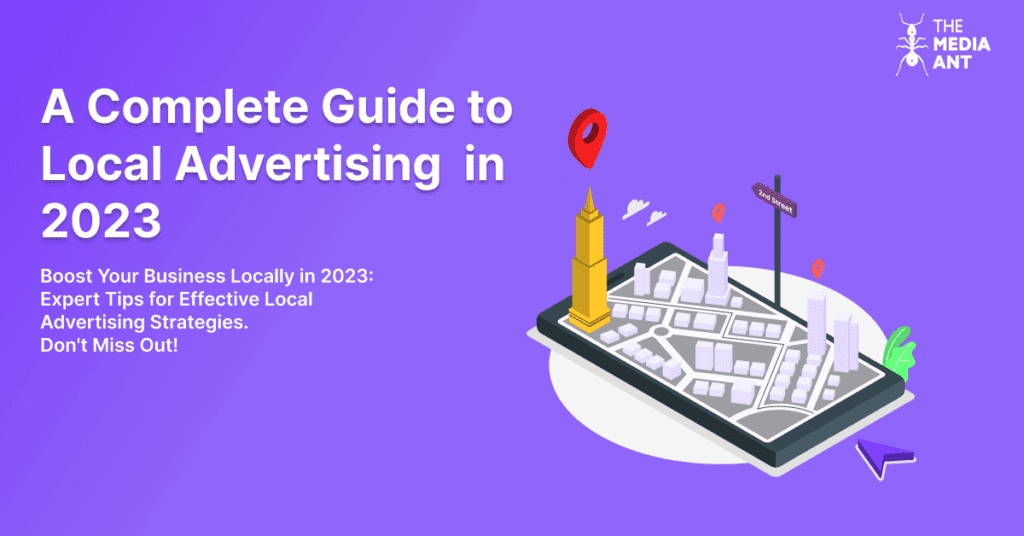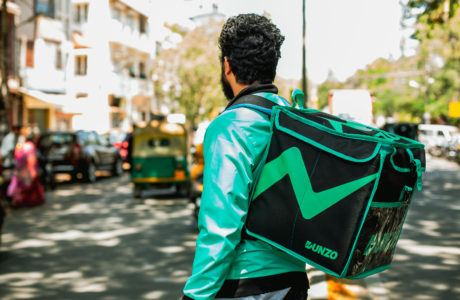Local advertising is like a secret weapon for businesses that want to connect with folks right in their neighborhood or community. Whether you run a cozy little family store or a big chain with branches all around, knowing the ins and outs of local advertising is the key to bringing in local customers.
So, let’s take a deep dive into the world of local advertising in this friendly guide. We’re going to break down what it’s all about, toss around tons of cool local marketing ideas, and chat about how much it might cost you to get in on the action.
What’s the Deal with Local Advertising?
Alright, so first things first, what exactly is local advertising? Well, it’s like putting up a signpost that says, “Hey, we’re right here, come check us out!” Local advertising is all about getting the attention of people who live or work nearby, and it can happen in many ways – online, in your town’s newspaper, or even on the radio.
What is Local Advertising?
Local advertising refers to promotional activities and marketing strategies designed to reach a specific local audience or geographic area. Its primary goal is to connect businesses with potential customers in their immediate vicinity.
Local advertising can take various forms, both offline and online, including print ads, radio spots, social media campaigns, and search engine marketing. Its effectiveness lies in its ability to foster relationships with local customers and drive foot traffic to physical locations.
Local Marketing Ideas – Let’s Get Creative
- Google My Business (GMB): Claiming and optimizing your Google My Business listing is a fundamental step in local advertising. It ensures your business appears in local search results, complete with essential information such as your address, phone number, business hours, and customer reviews.
- Local SEO: Invest in search engine optimization (SEO) techniques that focus on local keywords, helping your website rank higher in local searches. Create locally relevant content, use location-based keywords, and build local backlinks to boost your online visibility.
- Social Media Advertising: Platforms like Facebook, Instagram, and Twitter offer powerful tools for local advertising. You can target users based on location, demographics, and interests. Run sponsored posts, host local events, and engage with the local community through social media.
- Local Partnerships: Collaborate with other local businesses, charities, or community organizations. Cross-promotion and joint events can help you tap into each other’s customer bases and strengthen your local presence.
- Email Marketing: Maintain a strong email list of local customers and send them tailored promotions, updates, and special offers. Personalized emails can encourage repeat business and loyalty.
- Local Print Media: Consider placing ads in local newspapers, magazines, and community newsletters. While print media has declined in popularity, it can still be effective in reaching older demographics and specific local niches.
- Outdoor Advertising: Invest in billboards, bus stop ads, or vehicle wraps in your local area. These physical advertisements can capture the attention of pedestrians and commuters in your vicinity.
- Local Events and Sponsorships: Sponsor or participate in local events, fairs, or festivals. Setting up a booth or providing branded merchandise can put your business in front of a large, engaged audience.
- Direct Mail Marketing: Send targeted postcards, flyers, or coupons to households in your area. Direct mail can be an effective way to reach local customers who might not be active online.
- Customer Reviews and Testimonials: Encourage satisfied customers to leave reviews on platforms like Yelp, TripAdvisor, or industry-specific review sites. Positive reviews can significantly influence local buying decisions.
The Evoke of ‘Regionalism’ in Advertising
The one-size fits all approach has taken a back seat in advertising. Due to the increasing interest in vernacular content, brands are now shifting their focus towards localized and culturally relevant advertising. This approach guarantees the highest effectiveness in business communication while also incorporating product integration.
With local content, brands expect to connect better with consumers of a certain cohort concentrated in a geographical area to get a higher return on investment. PhonePe’s ‘Tension Chhodo, Insurance Lo’ campaign aimed to dispel the misconception of South India being a homogenous region. The campaign featured four distinct advertisements for PhonePe insurance, each with different actors, settings, and subtleties.
In the case of Bisleri, the brand introduced language labels in Telugu (for Andhra Pradesh and Telangana), Marathi (for Maharashtra), and Hindi (for Uttar Pradesh) not only to establish a connection but also to combat counterfeit products.
Advertising in vernacular languages needs an in-depth understanding of not only the language but also the culture and social fabric of the region. For instance, Priya Marie the biscuits and confectionery brand that caters to individuals in West Bengal and derives its strength from the rich regional and cultural characteristics of the typical Bengali. It communicates with Bengalis using their own language, incorporating idiomatic expressions, grammar, and cultural references that resonate most effectively with the Bengali audience.
The television commercial (TVC) is broadcasted on regional channels such as Calcutta News, News18 Bangla, Enterr 10 Bangla, ABP Ananda, Sun Bangla, Zee Bangla, and other channels dedicated to the Bengali market. Additionally, it receives significant promotion across various social media platforms and YouTube.
Regional, tailor-made ads raise brand metrics much faster than a national campaign dubbed into a regional language. In the latest campaign of Dabur honey we see Rashmika Mandanna as their South ambassador and Ritabhari Chakraborty for West Bengal and Akshay Kumar for North market.
The BARC India Think Report, which analyzes advertisers across different language channels for the first quarter of 2022, indicates that Hindi channels attracted the largest share of both new and returning advertisers, accounting for 48%. Bengali channels witnessed the most significant growth, with a 16% increase in the number of advertisers compared to the same period in 2021, and Punjabi channels also experienced substantial growth, with an 18% increase compared to the first quarter of 2020. On the other hand, Tamil channels had the highest proportion of exclusive advertisers, making up 54% of their total advertiser base.
BharatPe- Rohit Sharma & KL Rahul
BharatPe’s ‘My Shop My Ad’ campaign, an unprecedented initiative within the fintech sector, had a straightforward objective: to enable countless offline retailers and kirana store proprietors across India to promote their businesses and distinguish themselves in a competitive market.
Through the BharatPe app, any merchant in India had the opportunity to design their custom advertisements featuring renowned cricketers such as Rohit Sharma and KL Rahul from the Indian Men’s International Cricket Team, all in a language that suited their preferences.
By utilizing images of their shop fronts as video backdrops and incorporating audio in four distinct regional languages including Hindi, Tamil, Kannada, and Telugu, along with renowned cricketers representing their stores, the campaign achieved two significant outcomes. Firstly, it assisted merchants in drawing in more customers, particularly during the festive period. Secondly, it reinforced BharatPe’s connection with these essential partners in business.
How Much Does Local Advertising Cost?
The cost of local advertising can vary widely based on several factors, including the type of advertising, your location, and the size of your target audience. Here are some key cost considerations for different local advertising methods:
Online Advertising: Online advertising costs can range from a few dollars per day for social media ads to hundreds or even thousands of dollars per month for pay-per-click (PPC) campaigns. The key is to set a budget that aligns with your business goals and monitor your return on investment (ROI) closely.
Print Media: Costs for print advertising can vary depending on the circulation of the publication, the size and placement of your ad, and the frequency of your ads. Local newspapers and magazines often offer packages for businesses looking to advertise regularly.
Outdoor Advertising: Billboards and bus stop ads typically involve monthly rental fees, which vary based on the location and visibility of the advertising space. Production costs for billboard artwork may also apply.
Direct Mail Marketing: Direct mail costs encompass printing, postage, and design. The price per piece can be reduced by sending larger quantities, but targeting specific households can increase the cost per piece.
Local Events and Sponsorships: The cost of participating in local events or sponsoring them can vary greatly. It’s essential to evaluate the potential exposure and audience reach when considering these opportunities.
Local SEO and SEM: Costs for local SEO and search engine marketing can range from a few hundred dollars per month for basic services to several thousand dollars for comprehensive campaigns. Budget allocation should be based on your business’s specific needs and competition in your area.
Google My Business: Claiming and optimizing your Google My Business listing is typically free. However, investing in professional photography, regular updates, and responding to customer reviews can enhance your listing’s effectiveness.
Conclusion
Local advertising is a dynamic and diverse field with numerous strategies and options to suit businesses of all sizes and niches. By understanding what local advertising is, exploring creative local marketing ideas, and carefully assessing your budget and goals, you can effectively connect with your local audience and drive growth for your business. Remember that consistency and adaptability are key in the world of local advertising, so continuously monitor and refine your strategies to achieve the best results.
H2: FAQs
H3: What is local advertising with example?
An example of local advertising would be a small, family-owned restaurant placing an ad in the local town’s newspaper or running Facebook ads that target users within a specific radius of their physical location. This way, they aim to attract nearby residents and encourage them to visit the restaurant.
H3: What is the meaning of local advertisement?
Local advertising refers to marketing and promotional activities that specifically target a localized or geographically defined audience, typically within a specific region, city, or community. This type of advertising aims to reach potential customers who are physically close to a business or service provider.
H3: What type of advertising is local advertising?
Local advertising is a specific subset of advertising that is distinguished by its geographical targeting. Other types of advertising include national advertising, which targets a broader national or international audience, and global advertising, which is aimed at a worldwide audience.





The complete information to nearby marketing on The Media Ant’s weblog is an precious resource! It brilliantly captures the essence of fantastic neighborhood advertising and marketing strategies, supplying sensible insights and actionable tips. The clear and concise breakdown of a range of structures and methods makes it an vital device for corporations aiming to maximize their neighborhood reach.